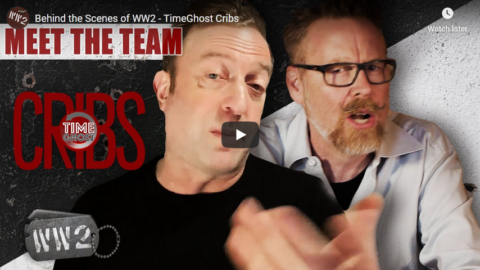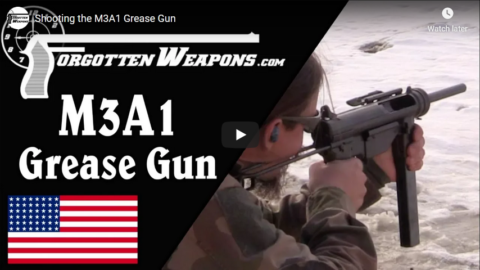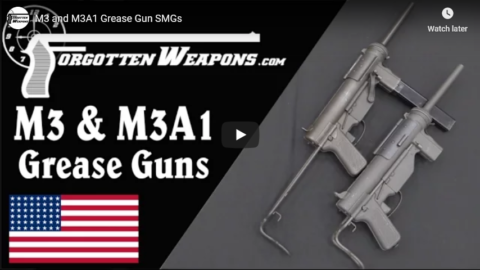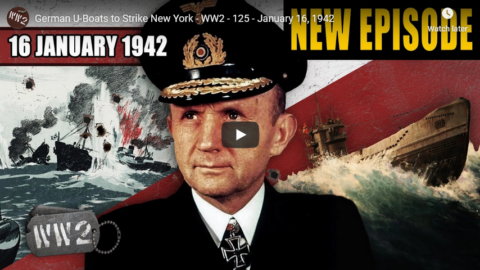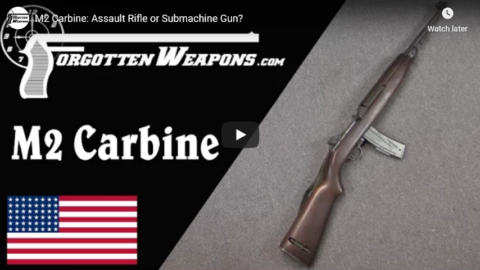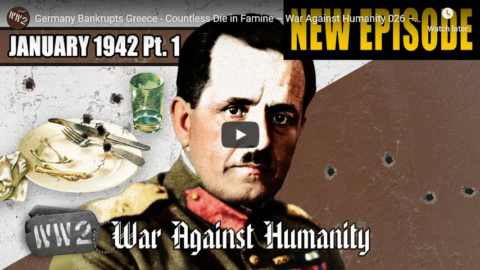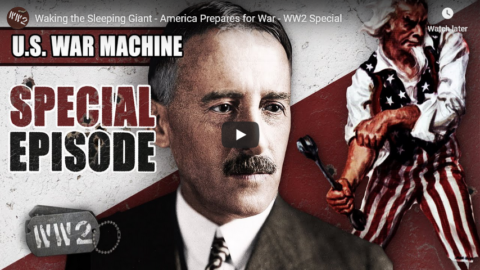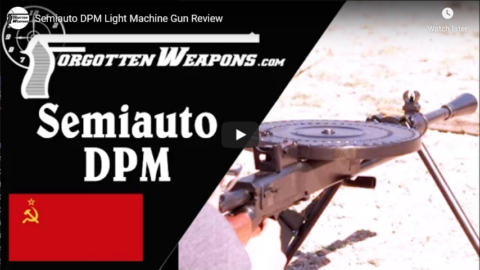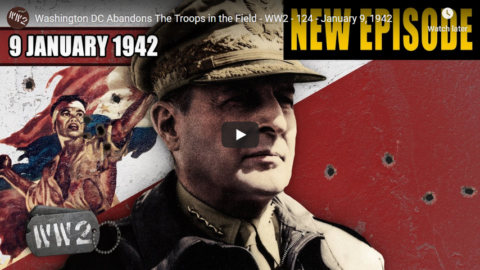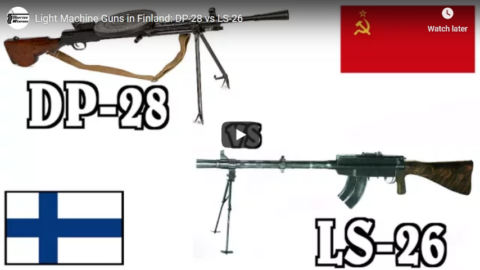World War Two
Published 26 Jan 2021This week we will start a series of videos where you get to know the team that makes this magnificent content.
Join us on Patreon: https://www.patreon.com/TimeGhostHistory
Or join The TimeGhost Army directly at: https://timeghost.tvFollow WW2 day by day on Instagram @ww2_day_by_day – https://www.instagram.com/ww2_day_by_day
Between 2 Wars: https://www.youtube.com/playlist?list…
Source list: http://bit.ly/WW2sourcesHosted by: Indy Neidell & Spartacus Olsson
Director: Astrid Deinhard
Producers: Astrid Deinhard and Spartacus Olsson
Executive Producers: Astrid Deinhard, Indy Neidell, Spartacus Olsson, Bodo Rittenauer
Creative Producer: Maria Kyhle
Post-Production Director: Wieke Kapteijns
Edited by: Karolina Dołęga
Sound design: Marek KamińskiA TimeGhost chronological documentary produced by OnLion Entertainment GmbH.
January 27, 2021
Behind the Scenes of WW2 – TimeGhost Cribs
January 25, 2021
Evolution of the Submachine Gun: Three Distinct Generations
Forgotten Weapons
Published 20 Oct 2020http://www.patreon.com/ForgottenWeapons
https://www.floatplane.com/channel/Fo…
Cool Forgotten Weapons merch! http://shop.bbtv.com/collections/forg…
Submachine guns have gone through a distinct evolution over the past one hundred years. Today we will look at these changes, specifically identifying:
– 1st Generation guns from World War One and through the 1930s
– 2nd Generation guns of World War Two
– 2nd Generation guns after World War Two
– 2nd Generation guns adapted to modern polymer manufacturing
– 3rd Generation guns in the form of rifle actions scaled down to pistol calibers
January 24, 2021
The Formalization of Extermination – The Wannsee Conference – WW2 – 126 – January 23, 1942
World War Two
Published 23 Jan 2021Nazi Germany’s “Holocaust by Bullets” has already claimed over a million lives over the past 8 months; this week German authorities hold a conference to streamline and systematize the process of extermination. Gas will now be the preferred method of murder. The Japanese are murdering Allied soldiers that fall into their hands as they advance ever closer to Singapore. The Soviet offensive continues along the entire Eastern Front, but the orders and objectives grow ever more confusing and chaotic. In North Africa, Erwin Rommel launches a surprise offensive against the Allies and make a lightning advance the final two days of the week.
Join us on Patreon: https://www.patreon.com/TimeGhostHistory
Or join The TimeGhost Army directly at: https://timeghost.tvFollow WW2 day by day on Instagram @ww2_day_by_day – https://www.instagram.com/ww2_day_by_day
Between 2 Wars: https://www.youtube.com/playlist?list…
Source list: http://bit.ly/WW2sourcesWritten and Hosted by: Indy Neidell
Director: Astrid Deinhard
Producers: Astrid Deinhard and Spartacus Olsson
Executive Producers: Astrid Deinhard, Indy Neidell, Spartacus Olsson, Bodo Rittenauer
Creative Producer: Maria Kyhle
Post-Production Director: Wieke Kapteijns
Research by: Indy Neidell
Edited by: Iryna Dulka
Sound design: Marek Kamiński
Map animations: Eastory (https://www.youtube.com/c/eastory)Colorizations by:
– Norman Stewart – https://oldtimesincolor.blogspot.com/
– Mikołaj Uchman
– Jaris Almazani (Artistic Man) – https://instagram.com/artistic.man
– Adrien Fillon – https://www.instagram.com/adrien.colo…Sources:
– IWM SE 4819
– Mil.ru
– Bundesarchiv
– ammo by Nociconist, Fruits by Icongeek26, Oil Tank by Mangsaabguru, from the Noun Project
– JoJan from Wikimedia Commons
– Yad Vashem 1427_85, 2CO1, 4613_360Soundtracks from the Epidemic Sound:
– Rannar Sillard – “Easy Target”
– Flouw – “A Far Cry”
– Fabien Tell – “Weapon of Choice”
– Reynard Seidel – “Rush of Blood”
– Edward Karl Hanson – “Spellbound”
– Johan Hynynen – “Dark Beginning”
– Johannes Bornlöf – “The Inspector 4”
– Gunnar Johnsen – “Not Safe Yet”
– Rannar Sillard – “Split Decision”
– Howard Harper-Barnes – “London”
– Christian Andersen – “Barrel”
– Cobby Costa – “From the Past”Archive by Screenocean/Reuters https://www.screenocean.com.
A TimeGhost chronological documentary produced by OnLion Entertainment GmbH.
January 22, 2021
Japan’s Only Pacific “Ally” – Phibun’s Thailand – WW2 Biography Special
World War Two
Published 21 Jan 2021Thailand’s prime minister and de-facto dictator Plaek Phibunsongkhram imported European fascism, nationalism and militarism to his country. But when Japan’s threat to South-East Asia became imminent, Phibun didn’t know what to do. His story is one of utter indecisiveness and opportunism.
Join us on Patreon: https://www.patreon.com/TimeGhostHistory
Or join The TimeGhost Army directly at: https://timeghost.tvFollow WW2 day by day on Instagram @ww2_day_by_day – https://www.instagram.com/ww2_day_by_day
Between 2 Wars: https://www.youtube.com/playlist?list…
Source list: http://bit.ly/WW2sourcesHosted by: Indy Neidell
Written by: Joram Appel
Director: Astrid Deinhard
Producers: Astrid Deinhard and Spartacus Olsson
Executive Producers: Astrid Deinhard, Indy Neidell, Spartacus Olsson, Bodo Rittenauer
Creative Producer: Maria Kyhle
Post-Production Director: Wieke Kapteijns
Research by: Joram Appel
Edited by: Miki Cackowski
Sound design: Marek Kamiński
Map animations: Eastory (https://www.youtube.com/c/eastory)Sources:
IWM HU 675
Portrait of Plaek Phibunsongkhram, courtesy of 冯銮披汶 https://commons.wikimedia.org/wiki/Fi…
From the Noun Project: people by ProSymbols, tick by akash kSoundtracks from the Epidemic Sound:
Johannes Bornlof – “Deviation In Time”
Philip Ayers – “Trapped in a Maze”
Rannar Sillard – “March Of The Brave 4”
Fabien Tell – “Last Point of Safe Return”
Johannes Bornlof – “The Inspector 4”
Farrell Wooten – “Blunt Object”Archive by Screenocean/Reuters https://www.screenocean.com.
A TimeGhost chronological documentary produced by OnLion Entertainment GmbH.
Shooting the M3A1 Grease Gun
Forgotten Weapons
Published 9 Mar 2018The M3 (and its followup improved M3A1 model) was the United States’ answer to the high cost and manufacturing complexity of the Thompson submachine gun. The M3 “Grease Gun” (because really, that is what it looks like) was a very inexpensive weapon with a stamped and welded receiver and only a few milled parts. It also had the slowest rate of fire of any World War 2 submachine gun at about 450 rounds/minute. Its weight, compactness, and controllability made it almost universally preferred over the Thompson, at least by soldiers who had to carry and fight with either of them.
The Grease Gun is reputedly extremely controllable because of its low rate of fire, but this is my first time to actually try shooting one. Will it live up to that reputation?
http://www.patreon.com/ForgottenWeapons
Cool Forgotten Weapons merch! http://shop.bbtv.com/collections/forg…
If you enjoy Forgotten Weapons, check out its sister channel, InRangeTV! http://www.youtube.com/InRangeTVShow
Contact:
Forgotten Weapons
6281 N Oracle #36270
Tucson, AZ 85704
January 20, 2021
Hitler Never Gave the Order – So Who Did? – WW2 Special
World War Two
Published 19 Jan 2021The structure of decision-making in the Nazi Party and the German government is clouded in ambiguity and implicit power-structures. We explore how this leads to a rat-race, resulting in an endless spiral of irrational decisions and violence.
Join us on Patreon: https://www.patreon.com/TimeGhostHistory
Or join The TimeGhost Army directly at: https://timeghost.tvFollow WW2 day by day on Instagram @ww2_day_by_day – https://www.instagram.com/ww2_day_by_day
Between 2 Wars: https://www.youtube.com/playlist?list…
Source list: http://bit.ly/WW2sourcesWritten by: Joram Appel and Spartacus Olsson
Hosted by: Spartacus Olsson
Director: Astrid Deinhard
Producers: Astrid Deinhard and Spartacus Olsson
Executive Producers: Astrid Deinhard, Indy Neidell, Spartacus Olsson, Bodo Rittenauer
Creative Producer: Maria Kyhle
Post-Production Director: Wieke Kapteijns
Research by: Joram Appel
Edited by: Iryna Dulka
Sound design: Marek Kamiński
Map animations: Eastory (https://www.youtube.com/c/eastory)Colorizations by:
– Dememorabilia – https://www.instagram.com/dememorabilia/
– Olga Shirnina, a.k.a. Klimbim – https://klimbim2014.wordpress.com/
– Julius Jääskeläinen – https://www.facebook.com/JJcolorization/Sources:
– Yad Vashem 4331_15, 7283-146, 48AO4Soundtracks from the Epidemic Sound:
– Philip Ayers – “Ominous”
– Howard Harper-Barnes- “Underlying Truth”
– Craft Case – “Secret Cargo”
– Rannar Sillard – “Split Decision”
– Farrell Wooten – “Mystery Minutes” (STEMS INSTRUMENTS)
– Jon Bjork – “For the Many” (STEMS INSTRUMENTS)
– Philip Ayers – “Trapped in a Maze”Archive by Screenocean/Reuters https://www.screenocean.com.
A TimeGhost chronological documentary produced by OnLion Entertainment GmbH.
January 19, 2021
M3 and M3A1 Grease Gun SMGs
Forgotten Weapons
Published 14 Apr 2017The US began looking for a cost-effective replacement for the Thompson submachine gun in 1942, and the “Grease Gun” was the result. Designed by George Hyde (a noted firearms designer at the time) and Frederick Sampson (GM/Inland chief engineer), it was a very simple and almost entirely stamped firearm. Chambered for the .45ACP cartridge, it is notable for its very low rate of fire — 350-400 rpm, which made it quite controllable and easy to shoot for relatively inexperienced troops.
The M3 was a quite reliable gun (and what problems it did have were mostly due to its single-feed magazine and not the gun itself), but a revision program was begun in April 1944. This would produce the M3A1, which further simplified the design by removing the charging handle (which had been the one mechanical trouble point of the M3 anyway) and replacing it simply with a notch in the bolt to cock the gun with a finger.
While the M3 and M3A1 were replaced in front-line service in 1957, they would remain in military inventory as armament for tank crews and truck drivers until 1992 — quite the legacy for such a crude looking weapon!
http://www.patreon.com/ForgottenWeapons
Cool Forgotten Weapons merch! http://shop.bbtv.com/collections/forg…
If you enjoy Forgotten Weapons, check out its sister channel, InRangeTV! http://www.youtube.com/InRangeTVShow
QotD: British foods
… it is worth listing the foodstuffs, natural or prepared, which are especially good in Britain and which any foreign visitor should make sure of sampling.
First of all, British apples, one or other variety of which is obtainable for about seven months of the year. Nearly all British fruits and vegetables have a good natural flavour, but the apples are outstanding. The best are those that ripen late, from September onwards, and one should not be put off by the feat that most British varieties are dull in colour and irregular in size. The best are the Cox’s Orange pippin, the Blenheim Orange, the Charles Hoss, the James Grieve and the Russet. These are all eaten raw. The Bramley Seedling is a superlative cooking apple.
Secondly, salt fish, especially kippers and Scottish haddocks. Thirdly, oysters – very large and good, though artificially expensive. Fourthly, biscuits, both sweetened and unsweetened, especially those that come from the four or five great firms whose names are a trademark. Fifthly, jams and jellies of all kinds. These are usually best when home-made, with the exception of strawberry jam, which is nearly always better as a manufactured product. Some varieties not often seen outside Britain are blackcurrant jelly, bramble jelly (made of blackberries) marrow jam with ginger, and damson cheese, an especially stiff kind of jelly which can be cut in slabs. In addition, no one who has not sampled Devonshire cream, Stilton cheese, crumpets, potato cakes, saffron buns, Dublin prawns, apple dumplings, pickled walnuts, steak-and-kidney pudding and, of course, roast sirloin of beef with Yorkshire pudding, roast potatoes and horseradish sauce, can be said to have given British cookery a fair trial.
The only alcoholic drinks which are native to Britain, and are all widely drunk, are beer, cider and whiskey. The cider is fairly good (that brewed in Herefordshire is the best), the beer very good. It is somewhat more alcoholic and very much bitterer then the beers of most other countries, all save the mildest and cheapest kinds being strongly flavoured with hop. Its flavour varies greatly from one part of the country to another. The whiskey exported from Britain is mostly Scottish, but the Irish kind, which is sweeter in taste and contains more rye, is also popular in Britain itself. One excellent liquor, sloe gin, is widely made in Britain, though not often exported. It is always better when home-made. It is of a beautiful purplish-red colour, and rather resembles cherry brandy, but is of a more delicate flavour.
Finally, a word in praise of British bread. In general it is close-grained, rather sweet-flavoured bread, which remains good for three or four days after being baked. It is seen at its best in the kind of double loaf. Rye bread and barley bread are hardly eaten in Britain, but the wholemeal wheat bread is extremely good. The great virtue of British bread is that it is baked in small batches, in a rather primitive way, and therefore is not at all standardised. The bread from one baker may be quite different from another down the street, and one can range about from shop to shop until one is suited. It is a good general rule that small, old-fashioned shops make the best-flavoured bread. Throughout a great deal of the North of England the women prefer to bake their bread for themselves.
George Orwell, “British Cookery”, 1946. (Originally commissioned by the British Council, but refused by them and later published in abbreviated form.)
January 17, 2021
German U-Boats to Strike New York – WW2 – 125 – January 16, 1942
World War Two
Published 16 Jan 2021Operation Pauchenslag, long-range German submarines operating just off the US Coast, kicks into action this week, as does the Japanese invasion of the Dutch East Indies. They also take Kuala Lumpur. Meanwhile, the Soviet Red Army offensive all along the Eastern Front has its first full week of action, with the Soviets making some real territorial gains in the center, though a German offensive in the Crimea catches them off guard.
Join us on Patreon: https://www.patreon.com/TimeGhostHistory
Or join The TimeGhost Army directly at: https://timeghost.tvFollow WW2 day by day on Instagram @ww2_day_by_day – https://www.instagram.com/ww2_day_by_day
Between 2 Wars: https://www.youtube.com/playlist?list…
Source list: http://bit.ly/WW2sourcesWritten and Hosted by: Indy Neidell
Director: Astrid Deinhard
Producers: Astrid Deinhard and Spartacus Olsson
Executive Producers: Astrid Deinhard, Indy Neidell, Spartacus Olsson, Bodo Rittenauer
Creative Producer: Maria Kyhle
Post-Production Director: Wieke Kapteijns
Research by: Indy Neidell
Edited by: Karolina Dołęga
Sound design: Marek Kamiński
Map animations: Eastory (https://www.youtube.com/c/eastory)Colorizations by:
– Daniel Weiss
– Spartacus Olsson
– Mikołaj UchmanSources:
– National Archives NARA
– Narodowe Archiwum Cyfrowe NAC
– Imperial War Museums: NYP 45042, A 6920, HU 90349, A 7371, C3881, E 9572, A 7376, E 9569,
– Library of Congress
– Bundesarchiv
– United States Signal Corps. source – Washington County Free Library Photo WCRH018
– FDR Presidential Library
– United States Holocaust Museum
– Yad Vashem: 4613-1055, 5138-98, 86FO2, 4220-3,Soundtracks from Epidemic Sound:
– “Remembrance” – Fabien Tell
– “Dragon King” – Jo Wandrini
– “The Unexplored” – Philip Ayers
– “Maze Heist” – Max Anson
– “London” – Howard Harper-Barnes
– “Document This 1” – Peter Sandberg
– “First Responders” – Skrya
– “The End Of The World 2” – Håkan Eriksson
– “Dark Beginning” – Johan HynynenArchive by Screenocean/Reuters https://www.screenocean.com.
A TimeGhost chronological documentary produced by OnLion Entertainment GmbH.
January 16, 2021
M2 Carbine: Assault Rifle or Submachine Gun?
Forgotten Weapons
Published 23 Mar 2017The M2 Carbine was a mechanically simple modification of the M1 Carbine to allow fully automatic fire. The fire prototypes of the M1 Carbine had actually been selective-fire guns, but that requirement had been dropped by the time the Winchester design was officially adopted as the M1. It was a feature quickly requested by troops once the Carbine entered active service, though.
In 1944 the US Army acknowledged this, and introduced the M2. A total of 217,000 were manufactured at the end of WW2, and did see limited service on Okinawa — and then extensive use in the Korean War and Vietnam War.
The M1 Carbine has long generated controversy among those attempting to rigidly define its role, as it falls awkwardly between the notion of submachine gun and assault rifle, firing a cartridge that is clearly more powerful than a pistol round but equally clearly less powerful than an intermediate rifle round. Its originally intended role was as a personal defense weapon more effective than the 1911 pistol, and in service it always scored high marks for handiness and poor marks for combat effectiveness. The opinion of soldiers using the Carbine in either its M1 or M2 form was very much dependent on what role they expected it to serve.
In my opinion, its light weight and stock design make it a sub-optimal submachine gun, and its light cartridge makes it a sub-optimal assault rifle. But if you need a light and handy carbine to carry a lot and only use in emergencies, it is hard to beat for its time.
http://www.patreon.com/ForgottenWeapons
Cool Forgotten Weapons merch! http://shop.bbtv.com/collections/forg…
If you enjoy Forgotten Weapons, check out its sister channel, InRangeTV! http://www.youtube.com/InRangeTVShow
January 15, 2021
Germany Bankrupts Greece – Countless Die in Famine – War Against Humanity 026 – January 1942, pt. 1
World War Two
Published 14 Jan 2021The early weeks of 1942 show how much of a global War Against Humanity this really is. People in occupied zones across the globe suffer under the boot of their tormentors. In Greece, thousands die in a famine, while repressive tactics claim the lives of many more in the Balkans. The Holocaust continues in cities and the extermination camp of Chełmno, while the Japanese army wreaks havoc in South-East Asia as they advance on Allied positions.
Join us on Patreon: https://www.patreon.com/TimeGhostHistory
Or join The TimeGhost Army directly at: https://timeghost.tvFollow WW2 day by day on Instagram @ww2_day_by_day – https://www.instagram.com/ww2_day_by_day
Between 2 Wars: https://www.youtube.com/playlist?list…
Source list: http://bit.ly/WW2sourcesHosted by: Spartacus Olsson
Written by: Joram Appel
Director: Astrid Deinhard
Producers: Astrid Deinhard and Spartacus Olsson
Executive Producers: Astrid Deinhard, Indy Neidell, Spartacus Olsson, Bodo Rittenauer
Creative Producer: Maria Kyhle
Post-Production Director: Wieke Kapteijns
Research by: Joram Appel and Valantis Athanasiou
Edited by: Miki Cackowski
Sound design: Marek Kamiński
Map animations: Eastory (https://www.youtube.com/c/eastory)Colorizations by:
Jaris Almazani (Artistic Man) – https://instagram.com/artistic.man
Julius Jääskeläinen – https://www.facebook.com/JJcolorization/
Daniel WeissSources:
Yad Vashem 4147/72, 953, 4613/629, 85EO6
IWM KF 199, FE 255, SE 4819
Bundesarchiv
Narodowe Archiwum Cyfrowe
Museum of Yugoslavia
From the Noun Project: Skull by Muhamad UlumSoundtracks from the Epidemic Sound:
Johan Hynynen – “Dark Beginning”
Peter Sandberg – “Document This 1”
Skrya – “First Responders”
Cobby Costa – “From the Past”
Farrell Wooten – “Blunt Object”
Gunnar Johnsen – “Not Safe Yet”
Cobby Costa – “Flight Path”Archive by Screenocean/Reuters https://www.screenocean.com.
A TimeGhost chronological documentary produced by OnLion Entertainment GmbH.
January 13, 2021
Waking the Sleeping Giant – America Prepares for War – WW2 Special
World War Two
Published 12 Jan 2021As the United States enters World War Two, a huge industrial giant awakens from hibernation. This episode covers industrial mobilization plans, their execution, and their potential.
Join us on Patreon: https://www.patreon.com/TimeGhostHistory
Or join The TimeGhost Army directly at: https://timeghost.tvFollow WW2 day by day on Instagram @ww2_day_by_day – https://www.instagram.com/ww2_day_by_day
Between 2 Wars: https://www.youtube.com/playlist?list…
Source list: http://bit.ly/WW2sourcesHosted by: Indy Neidell
Written by: Joram Appel
Director: Astrid Deinhard
Producers: Astrid Deinhard and Spartacus Olsson
Executive Producers: Astrid Deinhard, Indy Neidell, Spartacus Olsson, Bodo Rittenauer
Creative Producer: Maria Kyhle
Post-Production Director: Wieke Kapteijns
Research by: Joram Appel
Edited by: Karolina Dołęga
Sound design: Marek Kamiński
Map animations: Eastory (https://www.youtube.com/c/eastory)Colorizations by:
Dememorabilia – https://www.instagram.com/dememorabilia/
Norman Stewart – https://oldtimesincolor.blogspot.com/Sources:
– Library of Congress
– National Archives NARA
– Picture of the first class of the Army Industrial College from National Defense University
– FDR Presidential Library & Museum
– Icons from the Noun Project: Artillery by Creative Mania, Douglas SBD Dauntless by Lluisa Iborra, Man by Milinda Courey, Factory Workers by Gan Khoon Lay, Soldier by Wonmo Kang, Old Car by Andri Graphic, progress 20% & 40% by Roberto Chiaveri.Soundtracks from Epidemic Sound:
– “The Inspector 4” – Johannes Bornlöf
– “London” – Howard Harper-Barnes
– “Break Free” – Fabien Tell
– “Last Point of Safe Return” – Fabien Tell
– “Force Matrix” – Jon BjorkArchive by Screenocean/Reuters https://www.screenocean.com.
A TimeGhost chronological documentary produced by OnLion Entertainment GmbH.
Semiauto DPM Light Machine Gun Review
Forgotten Weapons
Published 7 Mar 2017I have had a parts kit for a Soviet DPM light machine gun (actually a Polish one, but the design is identical) stashed away for many years now, with the hope to eventually have it built into a live gun. When I found out that SMG (makers of the sweet semiauto FG42 replicas) was making a new production run of DP and DPM barrels, receivers, and semiauto trigger conversions I jumped at my chance. I sent my kit to SMG, and they built it into this complete semiauto rifle.
The DP was introduced in 1928 as the standard Soviet light machine gun, and served through World War Two. In 1944, several defects were acknowledged and improved, notably the location of the recoil spring, the grip, and the bipod. This created the DPM, which did see some slight use at the very end of WW2, as well as use by several eastern bloc nations after the war (including in Korea). It would be updated again in 1946 with the RP46 conversion assembly to feed from Maxim belts instead of the distinctive pan magazines (and in fact, SMG is working on a reproduction of the RP46 conversion as well, although it is not yet ready).
Anyway, I took my new semiauto DPM out to the range and got a firsthand understanding of why these guns were so well liked by troops who used them. The design is nothing if not solid, rugged, and dependable. Like other iconic Soviet firearms, the DP/DPM is elegantly simple and bombproof. It is easy and comfortable to shoot, and SMG’s new and very clever linear hammer-fired semiauto conversion gives it a better trigger than any other semiauto machine gun conversion I have handled. Most such guns have really heavy and really creepy triggers, but this is about 8lb and very crisp – and that makes a huge difference in its shootability.
In a nutshell, the gun zeroed easily and shot well, it had no malfuctions in my 3 or 4 pans of ammo expended (using Czech surplus steel-case ammo), and was really a joy to shoot. I would not hesitate to recommend them, and SMG is offered everything from individual parts for you to build yourself to kit build services, and turnkey complete guns.
http://www.patreon.com/ForgottenWeapons
Cool Forgotten Weapons merch! http://shop.bbtv.com/collections/forg…
If you enjoy Forgotten Weapons, check out its sister channel, InRangeTV! http://www.youtube.com/InRangeTVShow
January 10, 2021
Washington DC Abandons The Troops in the Field – WW2 – 124 – January 9, 1942
World War Two
Published 9 Jan 2021The US government realizes that it cannot send help to relieve the US and Filipino forces in the Philippines, but it does not tell those forces. Meanwhile in the USSR, a huge Red Army offensive against entrenched German forces begins along the entire frontline. The Germans have pulled back in North Africa, though, to consolidate. The Japanese enter Manila and advance in Malaya, but are forced to withdraw in China.
Join us on Patreon: https://www.patreon.com/TimeGhostHistory
Or join The TimeGhost Army directly at: https://timeghost.tvFollow WW2 day by day on Instagram @ww2_day_by_day – https://www.instagram.com/ww2_day_by_day
Between 2 Wars: https://www.youtube.com/playlist?list…
Source list: http://bit.ly/WW2sourcesWritten and Hosted by: Indy Neidell
Director: Astrid Deinhard
Producers: Astrid Deinhard and Spartacus Olsson
Executive Producers: Astrid Deinhard, Indy Neidell, Spartacus Olsson, Bodo Rittenauer
Creative Producer: Maria Kyhle
Post-Production Director: Wieke Kapteijns
Research by: Indy Neidell
Edited by: Iryna Dulka
Sound design: Marek Kamiński
Map animations: Eastory (https://www.youtube.com/c/eastory)Colorizations by:
– Julius Jääskeläinen – https://www.facebook.com/JJcolorization/
– Jaris Almazani (Artistic Man) – https://instagram.com/artistic.man?ig…
– Carlos Ortega Pereira, BlauColorizations – https://www.instagram.com/blaucolorizations
– Norman Stewart – https://oldtimesincolor.blogspot.com/
– Michał UchmanSources:
– IWM FE 239
– Supermarine Spitfire By Joel Wisneski from the Noun Project
– Container by Shocho from the Noun ProjectMusic from Epidemic Sound:
– “Easy Target” – Rannar Sillard
– “Deflection” – Reynard Seidel
– “Growing Doubt” – Wendel Scherer
– “Secret Cargo” – Craft Case
– “Trapped in a Maze” – Philip Ayers
– “Not Safe Yet” – Gunnar Johnsen
– “Underlying Truth” – Howard Harper-Barnes
– “Spellbound” – Edward Karl Hanson
– “On the Edge of Change” – Brightarm Orchestra
– “Split Decision” – Rannar Sillard
– “Out the Window” – Wendel SchererArchive by Screenocean/Reuters https://www.screenocean.com.
A TimeGhost chronological documentary produced by OnLion Entertainment GmbH.
Light Machine Guns in Finland: DP-28 vs LS-26
Forgotten Weapons
Published 20 Jul 2017http://www.patreon.com/ForgottenWeapons
Before the Winter War, the standard light machine gun adopted by the Finnish military was the Lahti-Saloranta LS-26. This was a complex and finely built weapon, using a short recoil action and tilting bolt, chambered for the same 7.62x54mm rimmed cartridge as used by Finland’s Mosin-Nagant infantry rifles. The LS-26 fed from 20-round box magazines which are a bit unusual in having a single-feed presentation (which made them difficult to load without a tool, but also prevented potential problems from rimlock).
In total, about 5,000 LS26 machine guns were made for Finland (and an additional 1,200 sold to China in 8mm Mauser). They were apparently quite accurate, but highly prone to malfunctioning in the cold and dirty field conditions of Finnish combat. When the Winter War broke out and Finns began capturing Russian equipment, the Russian DP-28 light machine gun became a very popular alternative to the LS-26.
The Degtyarev DP-28 may not have been as refined of a weapon, but it was much better suited to real combat. It was simple and reliable, and the 47-round magazine capacity was certainly appreciated as well. By the end of the Continuation War, Finland had some 15,000 Degtyarev light machine guns in its inventory, far outnumbering the LS-26s.
Today Karl and I had a chance to fire both weapons side by side (unfortunately, my trigger time on the LS-26 was quite limited, and I was not able to film a full disassembly of it). We both found the LS-26 to be quite a challenging weapon to use effectively, even without any malfunctions. The Degtyarev was a much more usable machine gun.
One other interesting takeaway for us was the remarkable effectiveness of the semiautomatics DP/DPM made by SMG Guns here in the US. It delivered probably 90% of the utility of the original fully automatic version, which is quite impressive. After this comparison, I would recommend it even more heartily than before.
Special thanks to Varusteleka for arranging this shoot!
All photos in this video are courtesy of the excellent Finnish Defense Forces’ Photo Archive:
http://sa-kuva.fiCool Forgotten Weapons merch! http://shop.bbtv.com/collections/forg…
If you enjoy Forgotten Weapons, check out its sister channel, InRangeTV! http://www.youtube.com/InRangeTVShow

